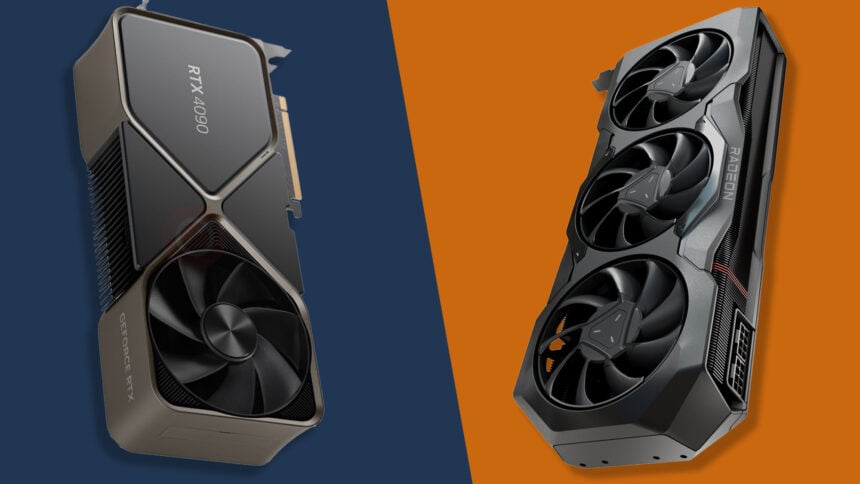When it comes to choosing a graphics card, two names stand out: AMD’s Radeon and Nvidia’s GeForce. Both companies have been fierce competitors in the GPU market, consistently pushing the boundaries of performance, technology, and value. This article will delve into various aspects of Radeon and Nvidia GPUs to help you make an informed decision based on performance, features, value, and other crucial factors.
1. Performance
Performance is a key consideration for gamers, content creators, and professionals.
- Radeon: AMD’s latest Radeon RX 7000 series, based on the RDNA 3 architecture, offers significant improvements in performance and efficiency. The flagship Radeon RX 7900 XTX delivers exceptional 4K gaming performance and competitive ray tracing capabilities.
- Nvidia: Nvidia’s GeForce RTX 40 series, powered by the Ada Lovelace architecture, remains the leader in raw performance. The RTX 4090 is unmatched in delivering top-tier gaming experiences, especially at 4K with ray tracing enabled. Nvidia’s DLSS (Deep Learning Super Sampling) technology also gives it an edge in rendering high-resolution graphics efficiently.
2. Ray Tracing and AI Features
Ray tracing and AI-driven features are essential for modern gaming and professional workloads.
- Radeon: AMD has made strides in ray tracing with its RX 6000 and 7000 series, but it still lags behind Nvidia in terms of performance and efficiency. However, AMD’s FSR (FidelityFX Super Resolution) offers a viable alternative to Nvidia’s DLSS, enhancing frame rates and visual quality across a wide range of games.
- Nvidia: Nvidia’s ray tracing capabilities are currently the best in the market. The RTX series was the first to introduce hardware-accelerated ray tracing, and with the 40 series, the performance has only improved. DLSS 3.0, which leverages AI to upscale lower resolution images, provides a noticeable boost in performance without compromising visual fidelity.

3. Software and Driver Support
Reliable software and driver support are critical for maintaining system stability and performance.
- Radeon: AMD’s drivers have improved over the years, offering a user-friendly interface and robust features through the Radeon Software Adrenalin Edition. The suite includes tools for performance monitoring, game optimization, and recording gameplay. However, AMD’s driver updates have occasionally been less stable than Nvidia’s.
- Nvidia: Nvidia’s GeForce Experience software is well-regarded for its ease of use and reliability. It offers features like automatic game optimization, driver updates, and in-game performance monitoring. Nvidia’s drivers are typically more stable and are released more frequently, ensuring better support for new game titles and features.
4. Value for Money
Value is a crucial factor, especially for budget-conscious consumers.
- Radeon: AMD has traditionally offered better value for money, especially in the mid-range and budget segments. The RX 6000 series, for instance, provides competitive performance at a lower price point compared to Nvidia’s offerings. AMD’s GPUs also tend to offer more VRAM for the price, which can be beneficial for certain applications.
- Nvidia: Nvidia GPUs are generally more expensive, particularly the high-end models. However, the premium price often comes with superior performance, better ray tracing, and advanced features like DLSS. For users who need the best performance regardless of cost, Nvidia remains the preferred choice.

5. Power Consumption and Efficiency
Power consumption and efficiency are increasingly important, especially with the rising cost of electricity.
- Radeon: AMD’s RDNA 3 architecture has made strides in power efficiency, but its GPUs still consume more power compared to Nvidia’s latest offerings. However, AMD’s improved efficiency with the RX 7000 series makes it a more viable option than previous generations.
- Nvidia: Nvidia’s 40 series GPUs are known for their power efficiency, thanks to the Ada Lovelace architecture. Despite their high performance, they manage to maintain reasonable power consumption levels, making them suitable for both high-performance gaming rigs and professional workstations.
6. Market Availability and Ecosystem
Availability and ecosystem support can influence the purchasing decision.
- Radeon: AMD has improved its supply chain and availability, but its GPUs can still be harder to find compared to Nvidia’s due to higher demand and production constraints. AMD’s ecosystem, including technologies like FreeSync, is widely supported but not as pervasive as Nvidia’s.
- Nvidia: Nvidia generally has better market availability, and its ecosystem is more extensive. Technologies like G-Sync, Reflex, and GameStream offer added value for users invested in the Nvidia ecosystem. Nvidia’s GPUs are also more commonly found in pre-built systems from major manufacturers.

Conclusion
Choosing between Radeon and Nvidia ultimately depends on your specific needs and budget.
- If you prioritize raw performance, advanced ray tracing, and AI features, Nvidia’s RTX 40 series is the way to go.
- If you’re looking for better value for money, particularly in the mid-range segment, AMD’s Radeon RX 7000 series offers compelling options.
Both AMD and Nvidia continue to innovate and push the boundaries of what’s possible in the GPU market, ensuring that consumers benefit from their intense competition. Whether you’re a gamer, a content creator, or a professional, both brands have something to offer, making it a great time to be in the market for a new graphics card.




